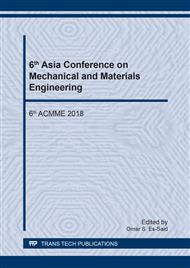p.24
p.30
p.35
p.43
p.50
p.55
p.61
p.66
p.73
Experimental and Modeling Study on the Curing Properties of Natural Rubber Composites Filled with Varying Proportions of Carbon Black, Modified Bentonite and Raw Bentonite
Abstract:
The aim of this study was to investigate the effect of replacing carbon black (CB) with inexpensive and environmentally friendly fillers – bentonite (BNT) and modified bentonite (M-BNT), on the curing properties of natural rubber (NR) composites. A control sample (unfilled NR) and thirteen NR composites filled with varied proportions of CB (x1), M-BNT (x2), and BNT (x3) based on a third degree – simplex lattice mixture design of experiment (DOE) were prepared in this study. Rheometric results showed that 33% substitution of CB with M-BNT provides the highest elastic torque values. Mixture of 10phr CB and 5phr M-BNT (CB/M-BNT/BNT 10/5/0) produces synergistic effect on curing. The presence of CB increases vulcanization rate due to its high basicity and low oxygen content while M-BNT serves as vulcanizing accelerator due to the present amine groups. Coefficients of reduced hierarchical models showed that the main factors contributed mainly on the curing parameters: β1 for the torque values, β2 for the scorch and curing time, and β3 for CRI. High values of coefficient of determination (r2) were computed particularly for MH (98.20%), ΔS (99.13%), ts2(95.68%), tc90(95.70%) and CRI (95.97%) establishing best fit between the model and experimental values.
Info:
Periodical:
Pages:
50-54
Citation:
Online since:
October 2018
Authors:
Keywords:
Price:
Сopyright:
© 2018 Trans Tech Publications Ltd. All Rights Reserved
Share:
Citation:


